My Dad, Fred, used to tell me many tales of his years in the RAF. He served in Bomber Command, and, as I grew older, stimulated perhaps by the increased interest generally in the Second World War, I made great efforts to find out the exact details of where he had served and what exactly he had done. This proved quite a challenge. Here he is with a few of his unduly optimistic friends during basic training: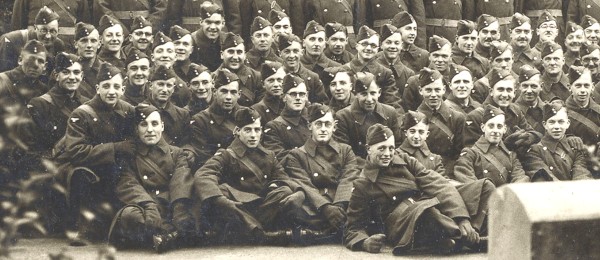
I do know that Fred served with 103 Squadron, probably in late 1943 and/or early 1944. This was the time of the Battle of Berlin which lasted from November 1943 to March 1944. My Dad did not take part in this titanic, and ultimately losing, struggle where 2,690 aircrew were killed in action and nearly a thousand became Prisoners of War. Bomber losses ran at 5.8% which is generally considered unsustainable. Crew morale was extremely low because of these huge casualties over “The Big City” as it was called, and luckily for him, Fred was never asked to bomb Berlin. Fred considered this to be the sole reason that he survived the war.
Here is the badge of 103 Squadron. The motto means “Don’t touch me”:
Fred spent his time with 103 Squadron at RAF Elsham Wolds which is between Scunthorpe and Grimsby, two places neither of which have ever been described as the Paris of the North, shall we say? Indeed, at the end of the conflict, one of my Dad’s great resentments, whatever he achieved against such a mad and bad enemy as the Germans were at that time, was that, like all the young men of Bomber Command, he knew damn well that they had all been forced to waste the best years of their lives, all of their youth, not pursuing pretty young girls at the village dance, but sitting in a Nissen hut in the middle of nowhere, feeling freezing cold and scared to death of a dangerous and precarious future. Fred’s twenty-first birthday, for example, had been celebrated, or rather, not celebrated, on a lonely, cold airfield in the middle of nowhere, far from his family. A definition which certainly would fit Elsham Wolds.
Here is Elsham Wolds on June 26th 1943, seen from about 10,000 feet up. Look for the three runways forming a huge triangle in the middle of the photo, and, on the right, five of the many circular dispersal points where the Lancaster bombers would wait impatiently for night to fall :
And here is a Nissen hut, named after Mr Nissen:
Today, very little remains of RAF Elsham Wolds. A major road, the A15, has been built more or less right through the middle of it, and on top of the majority of one runway. There is a single hangar left, apparently a J-type. Look for the orange arrow, pointing to the hangar:
It’s a funny feeling, though, to see a wartime building that your Dad would have known and no doubt loved when he was just nineteen or twenty years of age:
Here I have made gallant attempts to match up the aerial photograph of RAF Elsham Wolds in 1943 with the present countryside. The orange arrow still marks the J-type hangar. One runway has obviously disappeared under the A15. On the Ordnance Survey Map look for the number “78” and then the irregularly shaped four sided area to the left of it. It is bordered with yellow minor roads. You may be able to pick this distinctive shape out on the 1943 photograph:
This is half of the runway which, on the Ordnance Survey map, has the radio mast symbol on it. The buildings have something to do with the Severn Trent Water Authority, but were seemed to be unoccupied during our visit:
This is the runway which runs more or less west to east, if you refer back to the Ordnance Survey map. It has now become a dumping ground for builders’ rubble:
This is the Perimeter Track, or “Peri-track” running toward the start of the runway. When they set off on a mission, all the bombers would taxi slowly along the “Peri-track” to the start of whichever runway they were using that night:
The laws of trespass are quite different in England to many countries. Here, more or less, you can go wherever you want, provided you leave when you are asked to. Only too easy then, to take a Volvo saloon off the road, over ten yards of gravel, on to the old “Peri-track” and then round and off to the start of the runway. Here is where the bombers waited to take off:
Unfortunately, some idiot vandal builder has built a metal fence to stop me attempting a proper take-off so I have to stop the car and just drink in the scenery:
Nevertheless, let’s give it a go!
And I certainly knew what to do in my Lancaster. Accelerate as hard as possible. Keep your eye on the speed. When it reaches 130 mph, a gentle dab on the brakes and then, lift off. You’re on your way. Seriously though, it was good to think that I might have been doing exactly what Dear Old Dad had done 60 plus years ago. In a Lancaster, of course, not a Volvo:

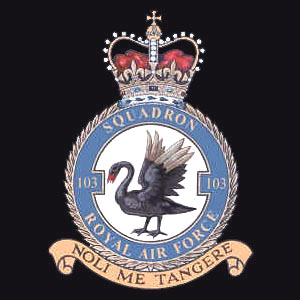
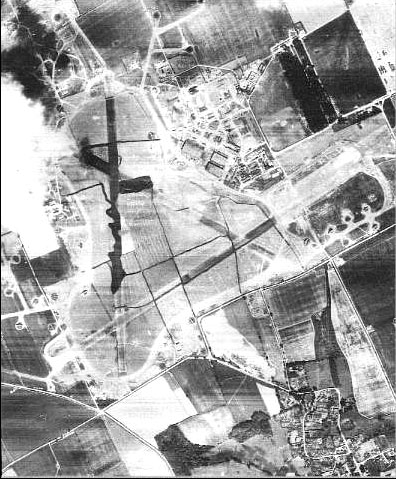

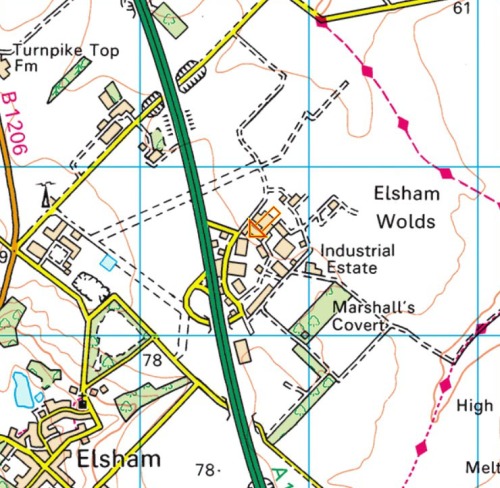



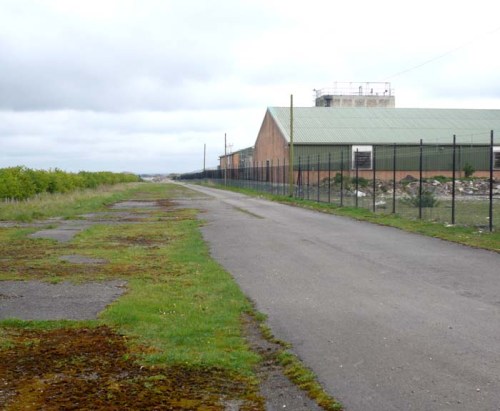

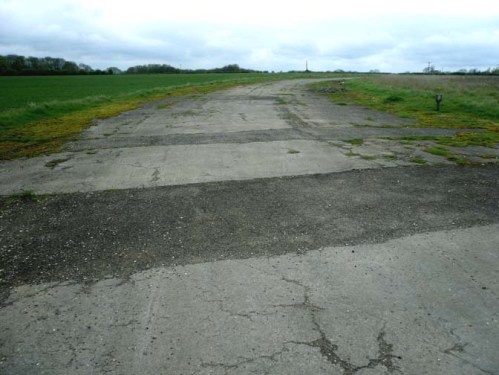
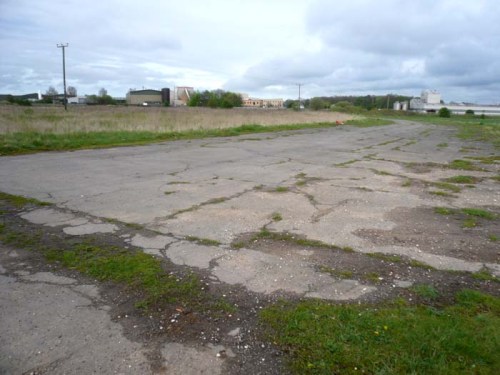
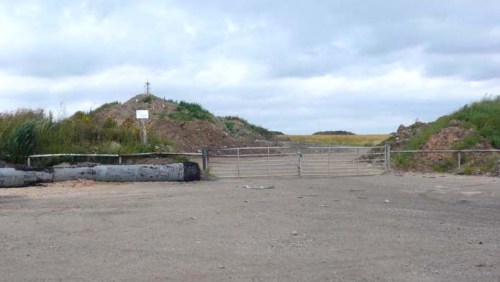




Just to be sure about what I will be commenting next…
Did you shoot that video?
No,it was my daughter.She stood on the front seat with her head through the sunroof!
Wonderful story! Nice takeoff – looks like you failed to get the 130mph mark though. Are they runways still capable of taking recreational pilots in small planes?
No, unfortunately, not. One runway is covered with thousands of tons of demolition rubble, and the second has buildings on half of it. The third runway has a major road built on it. It’s what happens to the past, unfortunately.
A lovely post. It’s always quite a feeling to walk or drive the same paths as those who went before us. I noticed the threshold markings on the runway that’s quite rare these days, I don’t recall ever seeing any at any of those I’ve been too. Great post I shall reblog. 🙂
This may be very belated. My dad, late F/S L.J.Maurice RAULT No. 188006 did spend some time at Elsham from 5th March to 24th March 1945. That seems very little time. Yet he wrote a book in French called Navigateur d’Occasion where he speaks a lot about Elsham and it ends on Elsham. He was a very rational man. He read law in UK and came 2nd for the whole Commonwealth in his final exams. He finished his career as Chief Justice of Mauritius and was knighted by the Queen. Nonethelesss in his book he
often refers to his lost friends whom he meets in his dreams or elsewhere and mostly at Elsham and he says its not over yet. Ghosts? I have translated the book into english but not yet edited same as the Mauritian readers have already read the French version. I am a member of Elsham Wolds Association.
Anyone interested in sharing some chapters? Danielle Lagesse
Thanks very much Danielle. I look forward to seeing your dad’s book appear in English.
Thank you Danielle, I’m sure that John, the originator of the post, will be interested to read your message. The book certainly sounds an interesting read.
Pingback: A trip around my Dad’s past: RAF Elsham Wolds | Aviation Trails
Thanks very much indeed! I didn’t actually find Elsham particularly uplifting. You can probably understand how finding literally thousands of tons of rubble dumped on the runways made me feel. Had it just been grassed over, or become wheat fields, fair enough, but so much builders’ rubble seemed to pass a fairly cruel verdict on the efforts of the two squadrons based there, and the sacrifices made by so many young men.
What we write about always takes a more emotive tone when there is a direct link to ourselves. I have always wanted to investigate my great grandfather’s war service on Malta. I have a few stories that have been passed down to me over the years but nothing concrete. I wouldn’t know where to begin thats the problem
I suppose it depends what war he was in. I tried to find out about a Nottingham Forest footballer who died of typhus in South Africa, and certainly the Boer War seems to have been completely forgotten.
He was a wireless operator on Malta during World War II. Thats all I know
BELATED REPLY: If I were you I would try writing to the RAF records department and explain your position. They may well be able to help you. I have the phone number of RAF Cranwell, and they could probably give you the address: RAF Cranwell, tel (direct): 01400 268 172.
Alternatively, if you give me his name, I will look him up on Forces-War-Records.
Very interesting read! The photos were great to see.
Thanks a lot for your interest!
Awesome post, John!!! I took a look at all those “boys” in your first picture and I just said, “OH, my heavens, they are just boys!” How I enjoyed your story and the way you pieced it all together, is brilliant. I really enjoyed your video because the angle it was taken actually felt as if I was in a plane. Tell your daughter she did an outstanding job on that video and her dad did an outstanding job on this post!!!! ❤
Thanks very much for dropping by, and for your kind words. I will pass on your compliments to my daughter. She always enjoys sentences which contain both her name and the words “outstanding job”.
SMILING. Don’t we all! LOL ❤
What a sensation to have been down the runway as your dad had so long ago, yes? And those Lancs were nearly impossible to bail out of safely. The crews had not enough room to board the plane with their chutes on. Rather, if they were going down, they had to scramble in very tight and unforgiving quarters to grab their chute, don it then get out.
You did a nice job on the maps!
You are absolutely right, it was very difficult to get out of the Lancaster and lots of people seemed to die fairly needlessly, As for the maps, I still don’t know why it was so difficult to twist them round, but it certainly was! Thanks a lot for dropping by.
I have a bit of a fascination with old airfields and Lancaster bombers. I can’t over how huge they were/are and how people suffered in them and because of them. All part of war unfortunately.
It must have been pretty special to retrace your dad’s journey.
Yes, it certainly was a very strange feeling. Thanks for dropping by.
Hi John, thanks – I enjoyed ready this about Elsham. My wife’s uncle was a pilot on 103 and I spent many years researching his story from volunteering through basic training, flying training and finally crewing up on 103 before failing to return. I managed to get photos of the other crew members and also details of their three trips to ‘happy valley’ together before they were all killed. I had so much that I was able to write a short paper and, have to say, I thoroughly enjoyed and found it fascinating to do. Every so often another little snippet comes up and you add a bit more… Some years ago, I went at stood at the threshold of the north westerly runway where Uncle Chris and the boys took off from on their final trip and it was quite eerie…not a breath of wind and you could imagine the ghostly sound of four Merlins under max boost as the brakes are released and the mighty Lanc’ surges forward… I can therefore empathise with your detail in the above pages. Thanks for sharing and helping to keep their memory alive sir. With best wishes to you. Per Ardua ad Astra. Spike.
Thanks very much indeed for your interest. I know what you mean about finding out one bit of info here and another there. Sometimes it means that I have to turn one blog post into two or three. This is what happened with this present series of posts. So, there will be six articles in total about Elsham Wolds and the men who served there. I hope you enjoy them all!
(And I still haven’t got on to my original idea…the seven different planes who took off from Elsham Wolds and were never seen again, just disappeared off the face of the earth.)
Hi John.
Read your articles with great interest. Particularly your comment about the seven planes that left Elsham Wolds and didn’t return. Apparently disappeared off the face of the earth. I believe that one of those aircraft was ND362 which was lost on the 28th May 1944 without any trace. My interest stems from my mothers husband who was the radio operation F/S William Clevey. I have also traced and keep in contact with the pilots daughter. I have some information that may be of interest.
Derek Gordon
Thank you for reading my post and for contacting me. I would be happy to see anything that may be of interest and I am, I suppose, a way of getting it out on to the internet. I just googled the Lancaster’s serial number, ND362, and found this:
http://ww2talk.com/index.php?threads/lancaster-nd362-pm-q.19846/
The various forums are always the best place to find things!
I really enjoyed your article. My Uncle was in 103 , sadly he was shot down in a raid on Stettin august of 1944. My parents seldom spoke of the war
so I’ve spent a fair amount of time researching my uncles service at Elsham Wolds. Your video and photos have helped bring his service to life
Thanks very much for your kind words, they are much appreciated. I suppose the one point I am trying to make is that every single young man or woman killed in a war causes ripples into so many other people’s lives, sometimes to disastrous effect. I was working on an article yesterday and found a young man killed in a training accident in 1944 at the age of 22. I don’t know if his young wife remarried, but she had until her own death in 2001 to mourn him. Nearly sixty years. It sounds as if your parents are in the same situation, unable to revisit tragedies of the past.
I’m glad you enjoyed the article. Thank you for passing by.
A nice read, my friend! ‘Noli MeTangere’ is also the title of a famous book here in the Philippines, written by our national hero, Jose Rizal.